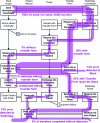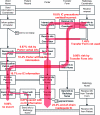A simulation framework for mapping risks in clinical processes: the case of in-patient transfers
- PMID: 21486883
- PMCID: PMC3078660
- DOI: 10.1136/amiajnl-2010-000075
A simulation framework for mapping risks in clinical processes: the case of in-patient transfers
Abstract
Objective: To model how individual violations in routine clinical processes cumulatively contribute to the risk of adverse events in hospital using an agent-based simulation framework.
Design: An agent-based simulation was designed to model the cascade of common violations that contribute to the risk of adverse events in routine clinical processes. Clinicians and the information systems that support them were represented as a group of interacting agents using data from direct observations. The model was calibrated using data from 101 patient transfers observed in a hospital and results were validated for one of two scenarios (a misidentification scenario and an infection control scenario). Repeated simulations using the calibrated model were undertaken to create a distribution of possible process outcomes. The likelihood of end-of-chain risk is the main outcome measure, reported for each of the two scenarios.
Results: The simulations demonstrate end-of-chain risks of 8% and 24% for the misidentification and infection control scenarios, respectively. Over 95% of the simulations in both scenarios are unique, indicating that the in-patient transfer process diverges from prescribed work practices in a variety of ways.
Conclusions: The simulation allowed us to model the risk of adverse events in a clinical process, by generating the variety of possible work subject to violations, a novel prospective risk analysis method. The in-patient transfer process has a high proportion of unique trajectories, implying that risk mitigation may benefit from focusing on reducing complexity rather than augmenting the process with further rule-based protocols.
Conflict of interest statement
Figures



Similar articles
-
Developing an efficient scheduling template of a chemotherapy treatment unit: A case study.Australas Med J. 2011;4(10):575-88. doi: 10.4066/AMJ.2011.837. Epub 2011 Oct 31. Australas Med J. 2011. PMID: 23386870 Free PMC article.
-
Combining patient journey modelling and visual multi-agent computer simulation: a framework to improving knowledge translation in a healthcare environment.Stud Health Technol Inform. 2014;204:25-31. Stud Health Technol Inform. 2014. PMID: 25087523
-
The future of Cochrane Neonatal.Early Hum Dev. 2020 Nov;150:105191. doi: 10.1016/j.earlhumdev.2020.105191. Epub 2020 Sep 12. Early Hum Dev. 2020. PMID: 33036834
-
Risk management frameworks for human health and environmental risks.J Toxicol Environ Health B Crit Rev. 2003 Nov-Dec;6(6):569-720. doi: 10.1080/10937400390208608. J Toxicol Environ Health B Crit Rev. 2003. PMID: 14698953 Review.
-
[Single-donor (apheresis) platelets and pooled whole-blood-derived platelets--significance and assessment of both blood products].Clin Lab. 2014;60(4):S1-39. doi: 10.7754/clin.lab.2014.140210. Clin Lab. 2014. PMID: 24779310 Review. German.
Cited by
-
A Systematic Literature Review of Agents Applied in Healthcare.J Med Syst. 2016 Feb;40(2):43. doi: 10.1007/s10916-015-0376-2. Epub 2015 Nov 21. J Med Syst. 2016. PMID: 26590981
-
Applying operations research to optimize a novel population management system for cancer screening.J Am Med Inform Assoc. 2014 Feb;21(e1):e129-35. doi: 10.1136/amiajnl-2013-001681. Epub 2013 Sep 16. J Am Med Inform Assoc. 2014. PMID: 24043318 Free PMC article.
-
Creating an oversight infrastructure for electronic health record-related patient safety hazards.J Patient Saf. 2011 Dec;7(4):169-74. doi: 10.1097/PTS.0b013e31823d8df0. J Patient Saf. 2011. PMID: 22080284 Free PMC article.
References
-
- Zegers M, de Bruijne MC, Wagner C, et al. Adverse events and potentially preventable deaths in Dutch hospitals: results of a retrospective patient record review study. Qual Saf Health Care 2009;18:297–302 - PubMed
-
- Runciman WB, Moller J. Iatrogenic Injury in Australia. Adelaide: Australian Patient Safety Foundation, 2001
-
- Iedema R. New approaches to researching patient safety. Soc Sci Med 2009;69:1701–4 - PubMed

